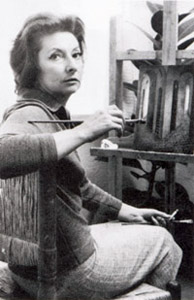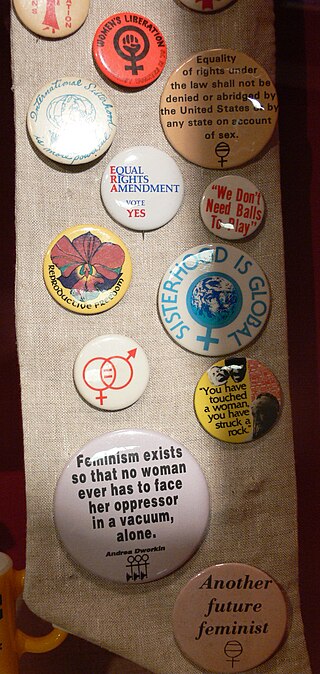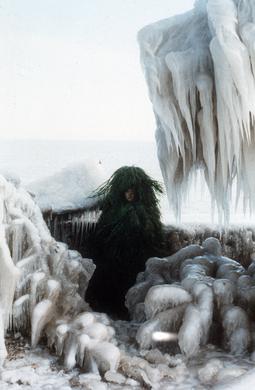Related Research Articles

Maria Mies was a German professor of sociology, a Marxist feminist, an activist for women's rights, and an author. She came from a rural background in the Volcanic Eifel, and initially trained to be a teacher. After working for several years as a primary school teacher and qualifying as a high school instructor, she applied to the Goethe Institute, hoping to work in Africa or Asia. Assigned to a school in Pune, India, she discovered that while her male students took German courses to further their education, women for the most part took her classes to avoid marriage. Returning to study at the University of Cologne, she prepared her dissertation about contradictions of social expectations for women in India in 1971, earning her PhD the following year.
Susan Griffin is a radical feminist philosopher, essayist and playwright particularly known for her innovative, hybrid-form ecofeminist works.

María de los Remedios Alicia Rodriga Varo y Uranga was a Spanish surrealist painter working in Spain, France, and Mexico.
Charlene Spretnak is an American author who has written nine books on cultural history, social criticism, religion and spirituality, and art.
Ruth Vanita is an Indian academic, activist and author who specialises in British and Indian literary history with a focus on gender and sexuality studies. She also teaches and writes on Hindu philosophy.
In the early 1960s, an interest in women and their connection with the environment was sparked, largely by a book written by Esther Boserup entitled Woman's Role in Economic Development. Starting in the 1980s, policy makers and governments became more mindful of the connection between the environment and gender issues. Changes began to be made regarding natural resource and environmental management with the specific role of women in mind. According to the World Bank in 1991, "Women play an essential role in the management of natural resources, including soil, water, forests and energy...and often have a profound traditional and contemporary knowledge of the natural world around them". Whereas women were previously neglected or ignored, there was increasing attention paid to the impact of women on the natural environment and, in return, the effects the environment has on the health and well-being of women. The gender-environment relations have valuable ramifications in regard to the understanding of nature between men and women, the management and distribution of resources and responsibilities, and the day-to-day life and well-being of people.

Ariel Salleh is an Australian sociologist who writes on humanity-nature relations, political ecology, social change movements, and ecofeminism.
Greta Gaard is an ecofeminist writer, scholar, activist, and documentary filmmaker. Gaard's academic work in the realms of ecocriticism and ecocomposition is widely cited by scholars in the disciplines of composition and literary criticism. Her theoretical work extending ecofeminist thought into queer theory, queer ecology, vegetarianism, and animal liberation has been influential within women's studies. A cofounder of the Minnesota Green Party, Gaard documented the transition of the U.S. Green movement into the Green Party of the United States in her book, Ecological Politics. She is currently a professor of English at University of Wisconsin-River Falls and a community faculty member in Women's Studies at Metropolitan State University, Twin Cities.

A variety of movements of feminist ideology have developed over the years. They vary in goals, strategies, and affiliations. They often overlap, and some feminists identify themselves with several branches of feminist thought.
Marti Kheel was a vegan ecofeminist activist scholar credited with founding Feminists for Animal Rights (FAR) in California in 1982. She authored several books in deep ecology and ecofeminism, including Nature Ethics: An Ecofeminist Perspective and several widely cited articles in college courses and related scholarship, such as "The Liberation of Nature: A Circular Affair", "From Heroic to Holistic Ethics: The Ecofeminist Challenge", and "From Healing Herbs to Deadly Drugs: Western Medicine's War Against the Natural World". She was a long-time vegan in diet, lifestyle, and philosophical commitments, working out her understanding of its implications in every area of our human relationships with nature and its constituents, and she found a wide audience for those deep reflections. Reportedly, she had pursued a raw vegan diet later in her life. Her pioneering scholarship in ecofeminist ethics is foundational for continuing work in these fields.
The Sister Chapel (1974–1978) is a visual arts installation, conceived by Ilise Greenstein and created as a collaboration by thirteen women artists during the feminist art movement. Before its completion, the critic and curator Lawrence Alloway recognized its potential to be "a notable contribution to the long-awaited legible iconography of women in political terms." The Sister Chapel is on permanent display at the Center for Art and Social Engagement, an initiative of the Rowan University Art Gallery in Glassboro, New Jersey.

Ecofeminism is a branch of feminism and political ecology. Ecofeminist thinkers draw on the concept of gender to analyse the relationships between humans and the natural world. The term was coined by the French writer Françoise d'Eaubonne in her book Le Féminisme ou la Mort (1974). Ecofeminist theory asserts a feminist perspective of Green politics that calls for an egalitarian, collaborative society in which there is no one dominant group. Today, there are several branches of ecofeminism, with varying approaches and analyses, including liberal ecofeminism, spiritual/cultural ecofeminism, and social/socialist ecofeminism. Interpretations of ecofeminism and how it might be applied to social thought include ecofeminist art, social justice and political philosophy, religion, contemporary feminism, and poetry.

Ecofeminist art emerged in the 1970s in response to ecofeminist philosophy, that was particularly articulated by writers such as Carolyn Merchant, Val Plumwood, Donna Haraway, Starhawk, Greta Gaard, Karen J. Warren, and Rebecca Solnit. Those writers emphasized the significance of relationships of cultural dominance and ethics expressed as sexism (Haraway), spirituality (Starhawk), speciesism, capitalist values that privilege objectification and the importance of vegetarianism in these contexts (Gaard). The main issues Ecofeminism aims to address revolve around the effects of a "Eurocentric capitalist patriarchal culture built on the domination of nature, and the domination of woman 'as nature'. The writer Luke Martell in the Ecology and Society journal writes that 'women' and 'nature' are both victims of patriarchal abuse and "ideological products of the Enlightenment culture of control." Ecofeminism argues that we must become a part of nature, living with and among it. We must recognize that nature is alive and breathing and work against the passivity surrounding it that is synonymous with the passive roles enforced upon women by patriarchal culture, politics, and capitalism.
Vegetarian ecofeminism is an activist and academic movement which states that all types of oppression are linked and must be eradicated, with a focus on including the domination of humans over nonhuman animals. Through the feminist concept known as intersectionality, it is recognized that sexism, racism, classism, and other forms of inter human discrimination are all connected. Vegetarian ecofeminism aims to include the domination of not only the environment but also of nonhuman animals to the list. Vegetarian ecofeminism is part of the academic and philosophical field of ecofeminism, which states that the ways in which the privileged dominates the oppressed should include the way humans dominate nature. A major theme within ecofeminism is the belief that there is a strong connection between the domination of women and the domination of nature, and that both must be eradicated in order to end oppression.
Josephine Donovan is an American scholar of comparative literature who is a professor emerita of English in the Department of English at the University of Maine, Orono. Her research and expertise has covered feminist theory, feminist criticism, animal ethics, and both early modern and American literature with a special focus on American writer Sarah Orne Jewett and the local colorists. She recently extended her study of local color literature to the European tradition. Along with Marti Kheel, Carol J. Adams, and others, Donovan introduced ecofeminist care theory, rooted in cultural feminism, to the field of animal ethics. Her published corpus includes ten books, five edited books, over fifty articles, and seven short stories.

Fern Shaffer is an American painter, performance artist, lecturer and environmental advocate. Her work arose in conjunction with an emerging Ecofeminism movement that brought together environmentalism, feminist values and spirituality to address shared concern for the Earth and all forms of life. She first gained widespread recognition for a four-part, shamanistic performance cycle, created in collaboration with photographer Othello Anderson in 1985. Writer and critic Suzi Gablik praised their work for its rejection of the technocratic, rationalizing mindset of modernity, in favor of communion with magic, the mysterious and primordial, and the soul. Gablik featured Shaffer's Winter Solstice (1985) as the cover art for her influential book, The Reenchantment of Art, and wrote that the ritual opened "a lost sense of oneness with nature and an acute awareness of ecosystem" that offered "a possible basis for reharmonizing our out-of-balance relationship with nature."
Catriona Sandilands is a Canadian writer and scholar in the environmental humanities. She is most well known for her conception of queer ecology. She is currently a Professor in the Faculty of Environmental Studies at York University. She was a Canada Research Chair in Sustainability and Culture between 2004 and 2014. She was a Fellow of the Pierre Elliott Trudeau Foundation in 2016. Sandilands served as president of the Association for the Study of Literature and Environment in 2015. She is also a past President of the Association for Literature, Environment, and Culture in Canada (ALECC) and the American Society for Literature and the Environment (ASLE).
Queer ecology is the endeavor to understand nature, biology, and sexuality in the light of queer theory, thus rejecting the presumption that heterosexuality and cisgenderedness constitute any objective standard. It draws from science studies, ecofeminism, environmental justice, and queer geography. These perspectives break apart various "dualisms" that exist within human understandings of nature and culture.

Theresa A. Yugar is a Latina feminist liberation theologian, notable for her work on the 17th-century nun, Sor Juana Inés de la Cruz.
Ecofeminism generally is based on the understanding that gender as a concept is the basis of the human-environment relationships. Studies suggest that there's a difference between men and women when it comes to how they treat nature, for instance, women are known to be more involved with environmentally friendly behaviors. Socially there's an important claim in the ecofeminism theoretical framework that the patriarchy is linked to discrimination against women and the degradation of the environment. In Canada the United Nations Special Rapporteur on Human Rights and Toxics in 2020 shows that ineffective environmental management and mismanagement of hazardous waste is affecting different age groups, genders, and socioeconomic status in different ways, while three years before that, Canadian Human Rights Commission in 2017 submitted another report, warning the government about how the exposure to environmental hazards is a different experience for minorities in Canada. There have been ecofeminist movements for decades all over Canada such as Mother's Milk Project, protests against Uranium mining in Nova Scotia, and the Clayoquot Sound Peace Camp. Ecofeminism has also appeared as a concept in the media, such as books, publications, movies, and documentaries such as the MaddAddam trilogy by Margaret Atwood and Fury for the Sound: the women at Clayoquot by Shelley Wine. Ecofeminism in the Canadian context has been subject to criticism, especially by the Indigenous communities as they call it cultural appropriation, non-inclusive, and inherent in colonial worldviews and structures.
References
- ↑ "GLORIA ORENSTEIN". Veteran Feminists of America, Inc. Retrieved 25 March 2017.
- 1 2 "Orenstein, Gloria Feman". Library of Congress Authorities. Library of Congress. Retrieved 25 March 2017.
- 1 2 Sturgeon, Noel (1997). Ecofeminist Natures: Race, Gender, Feminist Theory and Political Action. New York: Routledge. ISBN 9780415912495 . Retrieved 22 December 2017.
- ↑ "Gloria Feman Orenstein" . Contemporary Authors Online . 2010. Retrieved 13 March 2019– via Gale Biography In Context.
- 1 2 Carey, Catherine; Crawford, Stephanie (November 2010). "Inventory to the Gloria Orenstein Collection on Women Artists". Special Collections and University Archives, Rutgers University Libraries. Retrieved 24 December 2017.
- ↑ "Gloria F Orenstein". Faculty Profile. USC. Retrieved 13 December 2017.
- 1 2 3 Lauter, Estella (Autumn 1994). "Review: The Reflowering of the Goddess". Woman's Art Journal. 15 (2): 45–49. doi:10.2307/1358606. JSTOR 1358606.
- ↑ "WCA Lifetime Achievement Award". www.nationalwca.org. Retrieved 2018-03-24.
- ↑ "Gloria Orenstein". University of Southern California. Retrieved 15 Dec 2017.
- ↑ Diamond, Irene and Gloria Feman Orenstein, Ed. Reweaving the World: The Emergence of Ecofeminism, San Francisco: Sierra Club Books, 1990. Retrieved March 3, 2018.
- ↑ Orenstein, Gloria Feman. “Artists as Healers: Envisioning Life-Giving Culture,” In Reweaving the World, Irene Diamond and Gloria Feman Orenstein, Ed., San Francisco: Sierra Club Books, 1990, p. 279.
- ↑ Murray, Anne H. (1995). "Squidge Davis: Dialogue with Ancient Memories". Woman's Art Journal. 16 (1): 33–39. doi:10.2307/1358628. JSTOR 1358628.
- ↑ Ilie, Paul (1977). "Review: The Theater of the Marvelous: Surrealism and the Contemporary Stage by Gloria Orenstein". Hispanic Review. 45 (2): 222–224. doi:10.2307/472913. JSTOR 472913.
- ↑ Knapp, Bettina L. (1977). "Review of The Theater of the Marvelous by Gloria Orenstein". The Modern Language Journal. 61 (1/2): 68–69. doi:10.2307/325380. JSTOR 325380.
- ↑ Ryberg, Barbara (Autumn 1994). "Review:Multi-Cultural Celebrations: The Paintings of Betty LaDuke by Gloria Feman Orenstein". Woman's Art Journal. 15 (2): 59–60. doi:10.2307/1358614. JSTOR 1358614.
- ↑ Douglass, Carol Anne (November 1991). "Rethinking Ecofeminist Politics: Review of Reweaving the World". Off Our Backs. 21 (10): 11. JSTOR 20833817.
- ↑ Wickes, George (Spring 1980). "Comment on Orenstein's "The Salon of Natalie Clifford Barney: Interview with Berthe Cleyrergue"". Signs. 5 (3): 547–550. doi:10.1086/493746. JSTOR 3173601. S2CID 144817796.
- ↑ Russell, Diane H. (1980). "Review Essay: Art History". Signs. 3 (5): 468–481. doi:10.1086/493732. JSTOR 3173587. S2CID 225086748.
- ↑ "GLORIA ORENSTEIN - Professor of Comparative Literature and Gender Studies, FOUNDER OF THE WOMAN'S SALON FOR LITERATURE". Veteran Feminists of America. Veteran Feminists of America. Retrieved 13 December 2017.